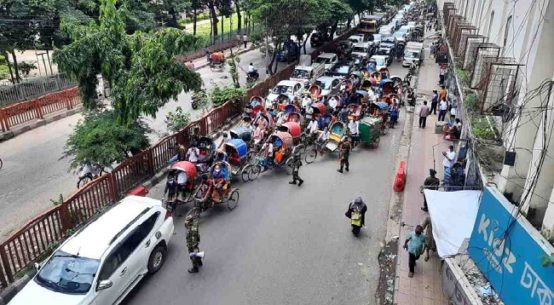
The government is hoping to return the economy to its pre-COVID growth momentum by the end of the current fiscal (2023-24), although that presents a significant challenge in the face of a clutch of economic headwinds.
The government’s vision for economic recovery is outlined in the “Medium Term Macroeconomic Policy Statement 2023-24 to 2025-26,” prepared by the Macroeconomy Wing of the Finance Division, under the Finance Ministry.
It maintains that with the onset of the pandemic in 2020, the economy was knocked off its fast-paced growth trajectory for large parts of the last three years. The first confirmed cases of Covid-19 in Bangladesh were reported in March 2020, less than three months after the outbreak in Wuhan.
Recently published quarterly GDP data (in keeping with a condition set by the IMF) bears this out. It reveals that the economy contracted by a massive 7.86 percent in the last quarter of the 2019-20 fiscal (April to June 2020), as the virus spread throughout the globe.
According to the quarterly data released retrospectively by the Bureau of Statistics (BBS) last month, GDP had grown by between 6.5 to 8 percent in the first three quarters of 2019-20. That reflects the extent to which the wind was knocked out of the economy by the negative growth (contraction) in the fourth quarter.
The slump induced by Covid would keep economic performance depressed through the first two quarters of the next fiscal (2020-21). It wasn’t until the 3Q (January to March, 2021) that the first signs of a recovery would become visible.
As the 2021-22 fiscal kicked in, Bangladesh looked ready to put Covid-19 behind it, having implemented a successful vaccination programme and lifted lockdown restrictions. The economy rallied robustly, and GDP growth touched 10 percent in the third quarter (January to March 2022).
Yet even as the recovery was underway, the seeds for it to stumble were sown halfway across the globe, with Russia going to war in Ukraine in February 2022. The resulting volatility in international energy markets and supply chain disruptions would knock the momentum out again, of the country’s post-Covid recovery.
Although there was nothing like the contraction precipitated by Covid-19, the economy did experience a severe slowdown in the last quarter of FY22, slipping to just 2.6 percent from the previous quarter’s high of 10 percent.
“Bangladesh also braced for impacts on its economy. However, actual data shows that Bangladesh did impressively even during the height of the Covid-19 outbreak and is expected to return to pre-Covid growth trajectory by the end of FY 2023-24,” the statement surmises.
If everything goes according to plan and ‘assumptions hold’, it says that 8 percent GDP growth rate can be attained again in 2025-26.
“Therefore, the deviation of the actual from the planned growth envisaged in the 8th FYP (Five Year Plan) remained small,” it said.
The Macroeconomic Policy Statement mentions capital accumulation is key for development and hence the government aims to foster private investment along with public investment towards fulfilment of its goals..
Total investment in FY 2021-22 stood at 32 percent of GDP in which the contribution of the private and the public sectors were 24.5 and 7.5 percent, respectively. To achieve the long and medium-term growth targets, the level of investment will need to be increased further.
The statement points out that there is room to increase the implementation rate of public investment. If the pace of implementation of development projects can be increased, the required level of investment can be attained.
“Recognising this, the government has taken steps to bring about some structural changes in both project design and implementation levels,” it says in the statement.
The Finance Division document said that the Russia-Ukraine war has put global energy supplies at risk. Russia is a major global supplier of energy and hence when the war broke out, commodity prices spiked fast.
Bangladesh started to suffer from this like almost all other countries. By December 2022, point-to-point inflation rose to 8.7 percent and then further rose to 9.3 percent by March 2023.
However, global commodity prices are already falling, and central banks have raised policy rates and because of this it is expected that inflation will come down in the coming months.
The IMF has projected that the measures taken by the governments will help reduce inflation in the medium-term. The Finance Division has projected that average inflation will fall significantly to 6.0 percent in 2023-24, although there has been no indication of it through the first quarter (July to September).
In order to tame inflation and protect the incomes of the poor, the government has emphasised increasing the domestic production of essential items, while gradually tightening monetary policy.
The document says that food inflation hurts the poor the most. Keeping this in mind, the government through various measures, including subsidies and incentives, encouraged the growth of agricultural output.
To support the agriculture sector, disbursement of credit to the sector has been increased.
By the end of February 2023, the disbursement of agricultural credit and non-farm rural credit amounted to Tk. 210.66 billion in the first 8 months of the last fiscal, which was almost 14 percent higher, year on year.
With the help of supportive policies of the government, the general index of industrial production (medium and large-scale manufacturing) has been on the rise, reflecting expanded industrial production.
Dr Masrur Reaz, a prominent economist and public policy analyst, believes it would be very challenging to regain the pre-Covid momentum within the current fiscal, since a number of macroeconomic indicators have become unstable.
Talking to UNB, he suggested the government focus on stabilising the macroeconomic situation first, which would make the economy more sustainable in the long run.
Dr Reaz pointed out that high inflation, severe foreign exchange/dollar crisis preventing, among other things, opening of LCs, and the fluctuating value of domestic currency taka, should be resolved first.
“To bring the economy back to its pre-Covid growth rate, these issues should be resolved first, which itself would be very challenging and difficult in a short time,” he opined.
Explaining further, Dr Reaz said: “The time is to stabilise the economy rather than focus on growth. In the long run, the economy will grow through reducing the high rate of non-performing loans, keeping inflation within reasonable limits and achieving exchange rate stability.”


